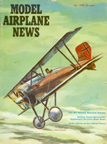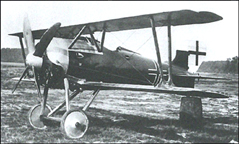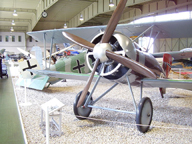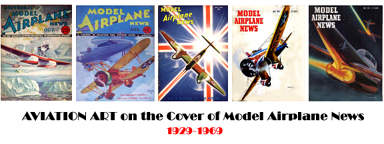July, 1960

Siemens-Schuckert D. IV
Model Airplane News Cover Art for July, 1960
by Jo Kotula
Click to Enlarge
The Siemens-Schuckert D.IV was a late-World War I fighter aircraft. It was considered by many to be the best fighter to see action during the war but it reached service too late and was produced in too few numbers to have any effect on the war effort. Siemens-Schuckert had entered the fighter-building business with an almost direct copy of the French Nieuport 17, the Siemens-Schuckert D.I. The plan was to equip it with an engine similar to the Nieuport's 80hp Le Rhône 9J, which was currently in production in Germany as the Oberursel UR.II. Supplies of the UR.II were extremely limited and none could be spared for SSW's production, so instead SSW decided to start production of their own version as the Siemens-Halske Sh.I. D.I's were intended to be delivered in late 1915. However, the engine ran into significant delays, and by the time they were ready for production in 1916 the design was no longer competitive. After a short run of 95 to be used as trainers, production of the D.I ended.


Siemens-Schuckert D. IV
Click to Enlarge
Siemens-Halske was unhappy with this turn of events, and started work on much larger engine designs to ensure they would not become outdated before entering service. One of these, the Siemens-Halske Sh.III, eventually matured into a workable design at 160 hp. Rotary engines with this sort of power would normally lead to terrible handling problems due to high torque, as it did on the Sopwith Camel, but the design team at Siemens-Halske came up with a clever solution to this problem. By running the engine's major interior mechanisms (the crankshaft, conrods and pistons) in a clockwise direction as seen from "nose-on", and a very large prop, along with the crankcase it was still fastened to, in a counterclockwise direction, the torque was reduced to a large degree. Additionally, a 2:1 ratio set of bevel gears at the rear of the crankcase allowed the engine to run at 1,800 RPM while the propeller spun at 900, allowing for a much larger and more efficient propeller. Without the step-down gearing a rotary would normally run at the same speed as the propeller, forcing the designer to trade off efficiency in either the engine or prop.
The Sh.III led to all of SSW's existing designs being re-engined for testing. In the case of the D.I, this led to a series of three prototype machines in known as the D.II, D.IIa and D.IIb. The primary difference between them and the original D.I was a much rounder and wider front fuselage to hold the larger engine, leading to a rather stubby-looking aircraft which pilots later referred to as the flying beer barrel. Flight tests started in June 1917, and while the plane did not have a very high top speed, it outclimbed anything else in the air. The only serious concern was the extremely long landing gear needed to keep the huge 2-bladed prop clear of the ground.
Here is a video of the Siemens-Schuckert D. IV in action:
Click Here for more information about the Siemens-Schuckert D. IV.

Click to go back and select another cover.
Counter for the Entire Site (not just this page..)
Home | About Lindy | Last Week's Reviews | Upcoming Events | 1940s Collecibles
The Guide - Establishments - Travel - Accessories
Music | Links | Photo Gallery | Extras | Contact